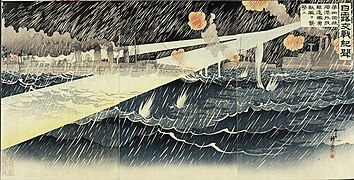Migita Toshihide
Toshihide Migita (右田 年英, Migita Toshihide, 1862 - 1925), also known as Oju Toshihide or Toshihide was a Japanese artist, creating work in traditional ukiyo-e prints and painting in the Western syle.[1]
Migita was apprenticed to Tsukioka Yoshitoshi. He also studied with Kinisawa Shimburō (1847–1877), who was an artist who had trained in Britain.[1]
Starting in 1877, his work was published in newspapers and magazines. His portraits of kabuki actors (yakusha-e) were well known.[1]
His war prints (戦争絵, sensō-e), in triptych format are considered to be important historical documents. This work documents Japan's participation in the First Sino-Japanese War and the Russo-Japanese War.[1]
-
 Mori Ranmaru killed at Honnō-ji, 1886
Mori Ranmaru killed at Honnō-ji, 1886 -
 Illustration of Chinese Generals from Pyongyang Captured Alive, October 1894 Collection of Museum of Fine Arts, Boston
Illustration of Chinese Generals from Pyongyang Captured Alive, October 1894 Collection of Museum of Fine Arts, Boston -
 Japanese destroyers attacking enemy (Russian) ships at Port Arthur, March 1904
Japanese destroyers attacking enemy (Russian) ships at Port Arthur, March 1904
See also

- War artists
Notes
- ^ a b c d Nussbaum, Louis Frédéric et al. (2005). "Migita Toshihide" in Japan Encyclopedia, p. 628.
References
- Nussbaum, Louis Frédéric and Käthe Roth. (2005). Japan Encyclopedia. Cambridge: Harvard University Press. ISBN 978-0-674-01753-5; OCLC 48943301
- v
- t
- e
  | This Japanese history–related article is a stub. You can help Wikipedia by expanding it. |
- v
- t
- e













